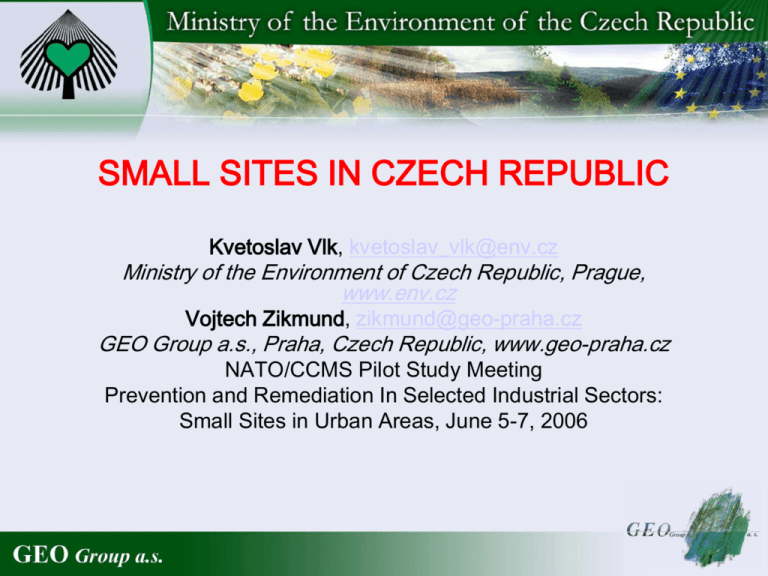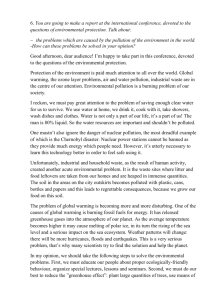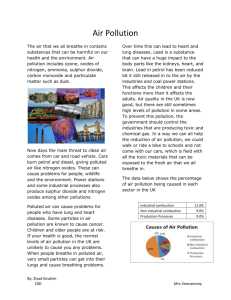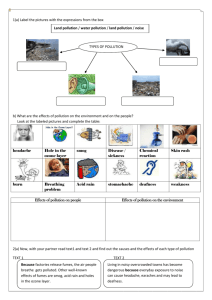Prezentace aplikace PowerPoint - CLU-IN
advertisement

SMALL SITES IN CZECH REPUBLIC Kvetoslav Vlk, kvetoslav_vlk@env.cz Ministry of the Environment of Czech Republic, Prague, www.env.cz Vojtech Zikmund, zikmund@geo-praha.cz GEO Group a.s., Praha, Czech Republic, www.geo-praha.cz NATO/CCMS Pilot Study Meeting Prevention and Remediation In Selected Industrial Sectors: Small Sites in Urban Areas, June 5-7, 2006 277 Environmental Liability Agreements concluded with private bodies (also with foreign subjects, e.g. Volkswagen Group etc.) Actually 82 environmental contracts were realized – 400 million €. Till June 2005 – 1 billion € was spent in old burdens clean up process. Old damages remediation fees are actually estimated in amount 3 – 6 billion €. A lot of small sites (represented mostly by small factories) are also covered by the ecological environmental contract But one small site is situated inside a megasite VITKOVICE STEEL in Ostrava • atypical small site – an isolated massively polluted spot in large iron works • nearly 180 years of history, due to growth of the city nowadays situated in the center of today´s Ostrava • area of iron works ca 3 km sq, the small site approx 3 ha (1 %), on the the northern edge of the territory The City of Ostrava OSTRAVA Vitkovice Steel Works Area 3 North – the area of the steel production technology, in operation since 1828 (blast furnaces, foundries, rolling mills, coking plant Area 2 Central auxiliary and transportation facilities (cooling water reservoir, pumping station, railways, coal and ore stores, oil tanks, in operation since 1915 Area 1 South Dump – pit Hrabuvka (inert material like slag, cinder, ash), in operation since 1890 British aircraft carrier The Illustrious, 1940 Landing deck armoured by steel sheets from Vitkovice Torpedo bombers Swordfish from the Illustrious on raid against Italian battleships Petroleum storage tanks Nelahozeves, Czech Republic Steel sheets designed and produced in Vitkovice Steel Works A view of the steel plant area 3, with the coking plant 1999 – before dismantling of technology Basic facts • Surface ca 300 ha • Start of industrial production and related pollution of soil and ground water in 1828 • Type of industry: foundry of raw steel from iron ore, heavy machinery, related chemistry of coal processing for production of coke and generator gas, auxiliary facilities • In the 90ies of 20th century with the rapid decrease of steel production a considerable part of technologies has been abandoned • The coking plant, without current maintenance, with hazardous chemicals still inside, represents a possible source of heavy pollution of its vicinity • To prevent fire or explosion, the technology has been filled by inert gas (nitrogen), and kept so, what represents high costs Supposed pollutants (on basis of US EPA methodology) • • • • • • • • Oil hydrocarbons Polyaromatic hydrocarbons (PAHs) BTEX (benzene, toluene, xylene and ethylbenzene) PCBs (polychlorinated biphenyles) - congeners 28, 52, 101, 118, 138, 153 a 180. Chlorinated aliphatic hydrocarbons 1,1-dichlorethene, 1,2-tdichlorethene, 1,2-c-dichlorethene, trichlorethene a tetrachlorethene. Metals (As, Ba, Be, Cd, Co, Cr tot., CrVI, Cu, Fe, Hg, Mn, Mo, Ni, Pb, Sb, Sn, V a Zn, Fe and Mn. Phenols Ions, further inorganic and organic pollutants Cl-, SO42-, F-, NH4+, CN tot, CN-, NO3-, NO2-, anionactive tensides (PAL-A). Documentation of the environmental load • expectations of a huge polluted area, ranging Vitkovice among the worst problems in the country, a probable mega-site • several surveys of pollution in the 90-ies of last century • risk analysis of the area of the coking plant in 1999 result: extremely high both technological risk (explosion, fire) and ecological (permanent leaking of chemicals in the neighborhood of the technologies) • risk analysis of the whole iron works Vitkovice in 2000 result: surprisingly low extent and consequent risk by the remaining area of the factory Pollution of soil (both saturated and unsaturated zones) LOCAL OCCURANCE LARGER POLLUTED AREAS Pollution of ground water LOCAL OCCURANCE LARGER POLLUTION SPOTS Area of the coking plant Critical level of soil pollution ISOLINE OF CRITICAL POLLUTION UNSATURATED ZONE ONLY SATURATED + UNSATURATED ZONES Area of the coking plant Critical levels of pollution of ground water PHENOLS OIL HYDROCARBONS AMMONIA PAHs BENZENE Commentary of the results • the area of the factory is affected by almost 180 years of steel and machinery production as a whole • ca 98 % area is practically without any serious ecological risk • the important threat is represented by one massively polluted subarea (the coking plant) and a series of small pollution spots • other environmental load is represented by old, partly polluted buildings planned for demolition • 1 % of the area, i.e. the abandoned technology of the coking plant, represents high technological and environmental risk • without immediate removal the foundations of the abandoned technology is a source of hazardous chemicals by large-scale leaking • through ground water flow and by gravitation creep the pollutants move eastward, in the direction of housing estates. METERS ABOVE SEA LEVEL GROUND WATER FLOW DIRECTION COMFORM WITH THE SURFACE OF THE TERTIARY LAYERS THE AREA OF THE COKING PLANT Ground water level in the areas 2 and 3 (affected by pollution) Area of coking plant Typical cross-section in W-E direction Direction of ground water flow: W-E 3 W 3’ E GROUND WATER TABLE SOIL, MADE-UP GROUND Level 196 m above sea Distance between boreholes GRAVEL LAYER TERTIARY CLAY Dismantling and cleaning of the metal components of the technology (2001 – 2003) Final study by supervising company a study has been carried out to summarize the results of the removal of the coking plant. It took into account all disponible new hydrogeological and technical data, with following results: • the most polluted materials (constructions, foundations, polluted soil) have been eliminated • leaking of chemicals from the technology has been stopped • backfilling of the excavations by impermeable material has practically stopped further infiltration of rain water • the migration of the pollution plume in the aquifer has been considerably slowed down • the risk represented by the pollution spot has been lowered to an acceptable level • there is no more high risk of pollution of further space through ground water flow, especially in the nearby housing estates • the remaining polluted materials of the saturated and unsaturated zones + PAHs on the basis of the quarternary aquifer will have to be treated before the revitalization of the whole area General plan of revitalization LOCAL POLLUTION SPOTS LARGER POLLUTED AREAS THE AREA OF THE COKING PLANT BUSINESS AND LIGHT INDUSTRY AREA FREE TIME ZONE Plans for further re-use of the territory • The territory of the former steel works is intended to be turned into a business and light industry area and a free time zone. • To enable this, the whole area will be formed by sloping, rain water drainage and covered by 0,5 m of fertile soil in free time zones. • In business and light industry zones, only measures to prevent contact of humans with soil (concrete or asphalt surfaces, vegetation cover) • These measures will be executed in steps, according to the plans of development of the city of Ostrava The important condition of application of this method of revitalization is naturally the removal of all the polluted soil, that remains in the sub-area of the former coking plant, eventually in other less important spots. Final remarks • This work will nevertheless be executed in the moment of the building of the intended new infrastructure and not necessarily now. • In this way, i.e. by solving imminent problems in time, it is possible, in some cases, to treat huge problems with relatively small means, i.e. like small sites. • The necessary procedure is represented by thorough investigation, good knowledge of geology and hydrogeology, by modelling the propagation of the pollution plume and by proving to the authorities, that early remediation of the pollution source is the right way to minimize environmental risks, costs and time of remediation. Generally said, by early mesures it is sometimes possible to prevent small areas from growing to the scale of mega-sites and on the other hand, to treat huge brownfields like small sites. CONCLUSION The continuous clean up process in Czech circumstances is still running and open. The issues concerning small sites are resolved and this aspect helps to reuse more and more expensive urban land inside the cities. Foreign investors prefere to buy companies where the absence of environmental burdens can be unambiguously demonstrated. At the end of our lecture, a few pictures from small sites in the Czech Republic. Sternberk, Moravia – during remediation – after remediation Pump and treat bore holes network at the old landfill TRESNOVEC (Eeastern Bohemia) Chlorinated hydrocarbons ground water pollution Decontamination point at the site of the old landfill Tresnovec (Eastern Bohemia) Decontamination point at the site of the old landfill Pisecna (Eastern Bohemia)







